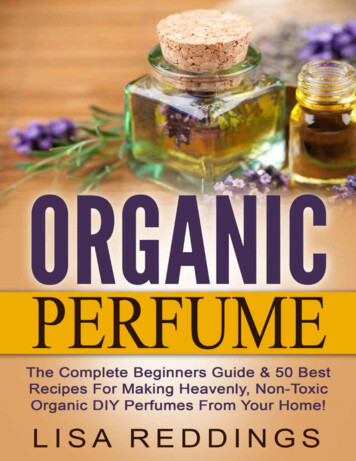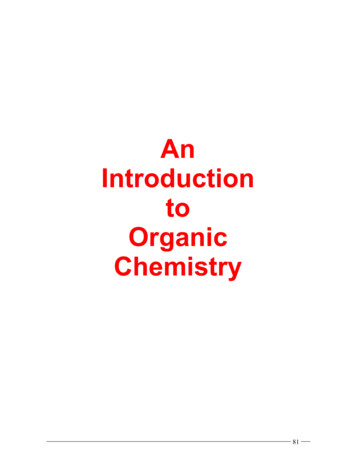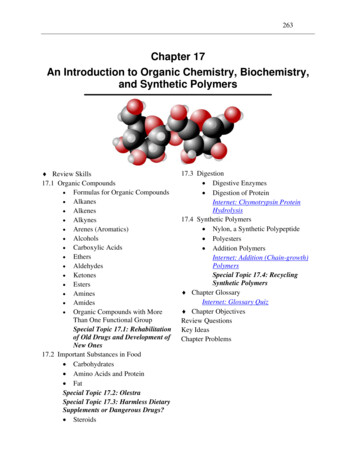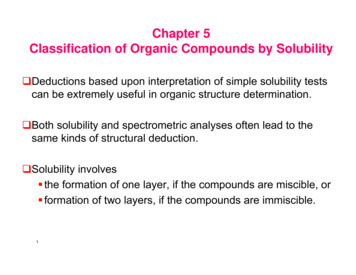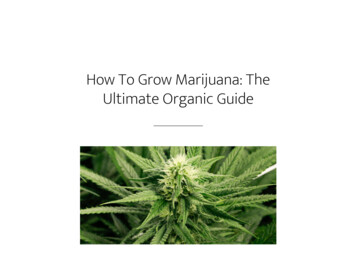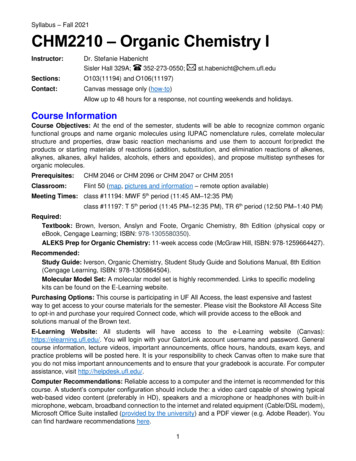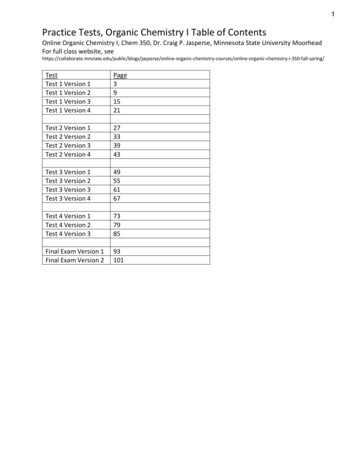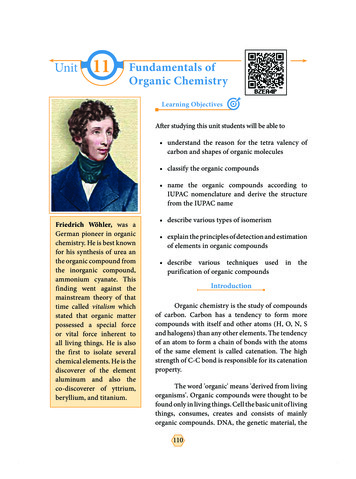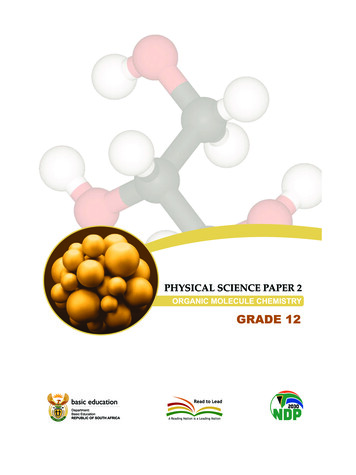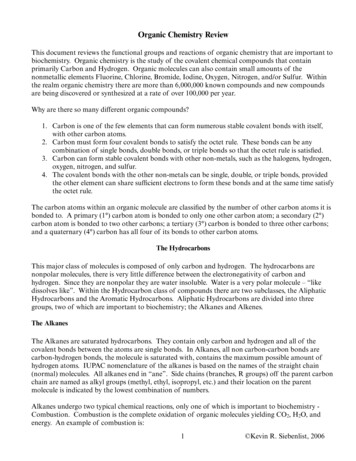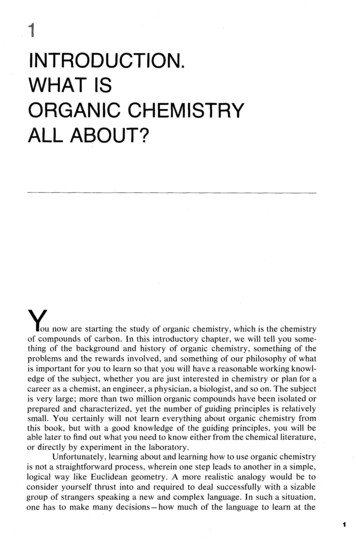
Transcription
1INTRODUCTION.WHAT ISORGANIC CHEMISTRYALL ABOUT?You now are starting the study of organic chemistry, which is the chemistryof compounds of carbon. In this introductory chapter, we will tell you something of the background and history of organic chemistry, something of theproblems and the rewards involved, and something of our philosophy of whatis important for you to learn so that you will have a reasonable working knowledge of the subject, whether you are just interested in chemistry or plan for acareer as a chemist, an engineer, a physician, a biologist, and so on. The subjectis very large; more than two million organic compounds have been isolated orprepared and characterized, yet the number of guiding principles is relativelysmall. You certainly will not learn everything about organic chemistry fromthis book, but with a good knowledge of the guiding principles, you will beable later to find out what you need to know either from the chemical literature,or directly by experiment in the laboratory.Unfortunately, learning about and learning how to use organic chemistryis not a straightforward process, wherein one step leads to another in a simple,logical way like Euclidean geometry. A more realistic analogy would be toconsider yourself thrust into and required to deal successfully with a sizablegroup of strangers speaking a new and complex language. In such a situation,one has to make many decisions- how much of the language to learn at the
1 Introduction. What is Organic Chemistry All About?2outset? Which people are the best to interact with first? Which will be the mostimportant to know in the long run? How well does one have to know eachperson? How much does one have to know about the history of the group tounderstand their interactions? These are difficult questions, and a period ofconfusion, if not anxiety, is expected in any attempt to complete a task of thiskind in a set, brief period of time. Clearly, it would be difficult to learn all atonce the language, the people, and the interactions between them. Nonetheless,this is pretty much what is expected of you in learning organic chemistry.A number of approaches have been devised to help you become familiarwith and use organic chemistry. In terms of our analogy, one way is to learnthe language, then the relationships between the people, and finally, well prepared, to proceed to interact with the people singly and then in groups. Suchan approach may be logical in concept, but is not to everyone's taste as a wayto learn. Many of us do better with an interactive approach, where language,relationships, and people are worked out more or less in concert, with attendant misunderstandings and ambiguities.What we will try to do is to introduce some of the important basic concepts and the elements of the language of organic chemistry, then show howthese are used in connection with various classes of compounds. The initialround will be a fairly extensive one and you should not expect to be able tomaster everything at once. This will take practice and we will provide opportunity for practice.One of the appealing yet bothersome features of modern organic chemistry is its extraordinary vitality. Unlike Euclidean geometry or classical mechanics, it is evolving rapidly and many of the concepts introduced in thisbook are either new or have been drastically modified in the past ten years.Every issue of the current chemical journals has material of such basic interestthat one would like to include it in an introductory course. Truly, those whowrite organic'textbooks write on water, with no hope of producing the definitivebook. Things just change too fast. Despite this, one of the great ideas of moderncivilization, namely that organic compounds can be described in terms of moreor less simple three-dimensional molecular structures with atoms held togetherby chemical bonds, has persisted for more than one hundred years and seemsunlikely to be superseded, no matter how much it is refined and modified.1-1 A BIT OF HISTORYYou may not be much interested in the way that organic chemistry developed,but if you skip to the next section without reading further, you will miss someof the flavor of a truly great achievement- of how a few highly creative chemists were able, with the aid of a few simple tools, to determine the structuresof molecules, far too small and too elusive to be seen individually with thefinest optical microscope, manifesting themselves only by the collective behavior of at least millions of millions at once.
1-1 A Bit of HistoryTry to visualize the problems confronting the organic chemist of 100years ago. You will have no more than reasonably pure samples of organiccompounds, the common laboratory chemicals of today, glassware, balances,thermometers, means of measuring densities, and a few optical instruments.You also will have a relatively embryonic theory that there are molecules inthose bottles and that one compound differs from another because its molecules have different members or kinds of atoms and different arrangementsof bonds. Your task will be to determine what kinds and what numbers ofatoms they contain, that is, to determine their molecular formulas. Obviously,a compound with formula C,H,O and one with C,H,O, are not the same compound. But suppose two compounds from different sources both are C,H,O.T o decide whether these are the same or different you could smell them (farbetter to sniff than to inhale), taste them (emphatically not recommended),see if they have the same appearance and viscosity (if liquids), or use moresophisticated criteria: boiling point, melting point, density, or refractive index.Other possibilities would be to see if they both have the same solubility inwater or other solvents and whether they give the same reaction products withvarious reagents. Of course, all this gets a bit tough when the compounds arenot pure and no good ways are available to purify them, but that is part of thejob. Think about how you might proceed.In retrospect it is surprising that in less than fifty years an enormous,even if incomplete, edifice of structural organic chemistry was constructedon the basis of the results of chemical reactions without determination of asingle bond distance, and with no electronic theory as a guide. Interestingly,all of the subsequent developments of the quantum mechanical theory of chemical bonds has not altered this edifice in significant ways. Indeed, for a longtime, a goal of molecular quantum mechanics was simply to be able to corroborate that when an organic chemist draws a single line between two carbonatoms to show that they are bonded, he in fact knows what he is doing. Andthat when he draws two (or three) bonds between the carbons to indicate adouble (or triple) bond, quantum mechanics supports this also as a valid idea.Furthermore, when modern tools for determining organic structures thatinvolve actually measuring the distances between the atoms became available,these provided great convenience, but no great surprises. To be sure, a fewstructures turned out to be incorrect because they were based on faulty orinadequate experimental evidence. But, on the whole, the modern threedimensional representations of molecules that accord with actual measurements of bond distances and angles are in no important respect different fromthe widely used three-dimensional ball-and-stick models of organic molecules,and these, in essentially their present form, date from at least as far back asE. Paterno, in 1869.How was all of this achieved? Not by any very simple process. Theessence of some of the important ideas follow, but it should be clear that whatactually took place was far from straightforward. A diverse group of peoplewas involved; many firmly committed to, if not having a vested interest in,earlier working hypotheses or paradigms that had served as useful bases forearlier experimentation, but were coming apart at the seams because they could
1 lntroduct onWhatISOrgan cChemistry All About?not accommodate the new facts that kept emerging. As is usual in human endeavors, espousal of new and better ideas did not come equally quickly to allthose used to thinking in particular ways. To illustrate, at least one famouschemist, Berthelot, still used H O as the formula for water twenty-five yearsafter it seemed clear that H,O was a better choice.1-1A Determination of Molecular FormulasBefore structures of molecules could be established, there had to be a meansof establishing molecular formulas and for t h spurpose the key concept wasAvogadro's hypothesis, which can be stated in the form "equal volumes ofgases at the same temperature and pressure contain the same number of molecules." Avogadro's hypothesis allowed assignment of relative molecularweights from measurements of gas densities. Then, with analytical techniquesthat permit determination of the weight percentages of the various elementsin a compound, it became possible to set up a self-consistent set of relativeatomic weightsS1From these and the relative molecular weights, one can assignmolecular formulas. For example, if one finds that a compound contains 22.0%carbon (atomic weight 12.00), 4.6% hydrogen (atomic weight 1.008), and73.4% bromine (atomic weight 79.90), then the ratios of the numbers ofatoms are (22.0/12.00):(4.6/1.008):(73.4/79.90) 1.83:4.56:0.92. Dividingeach of the last set ofnumbers by the smallest (0.92)gives 1.99:4.96:1 2 2:5:1,which suggests a molecular formula of C,H,Br, or a multiple thereof. If weknow that hydrogen gas is H, and has a molecular weight of 2 X 1.008 2.016,we can compare the weight of a given volume of hydrogen with the weight ofthe same volume of our unknown in the gas phase at the same temperatureand pressure. If the experimental ratio of these weights turns out to be 54,then the molecular weight of the unknown would be 2.01 6 x 54 109 and theformula C,H,Br would be correct (see Exer ise1- 15).1-1B ValenceIf we assume that the molecule is held together by chemical bonds, withoutknowing more, we could write numerous structures such as H-H-HH-H-C-C-Br,H-C-Br-H-H-C-H-H,and so on. However, if we also know of the existence of stable H,, but not H,; of stable Br,,but not of Br,; and of stable CH,Br, CH,Br,, CHBr,, and CBr,, but not ofCH,Br, CHBr, CBr, and so on, a pattern of what is called valence emerges.lWe will finesse here the long and important struggle of getting a truly self-consistenttable of atomic weights. If you are interested in the complex history of this problemand the clear solution to it proposed by S. Cannizzaro in 1860, there are many accountsavailable in books on the history of chemistry. One example is J. R. Partington, AHistory of Chemistry, Vol. IV, Macmillan, London, 1964. Relative atomic weightsnow are based on I2C 12 (exactly).
1-1 C Structural FormulasIt will be seen that the above formulas all are consistent if hydrogen atomsand bromine atoms form just one bond (are univalent) while carbon atoms formfour bonds (are tetravalent). This may seem almost naively simple today, buta considerable period of doubt and uncertainty preceded the acceptance of theidea of definite valences for the elements that emerged about 1852.1-1C Structural FormulasIf we accept hydrogen and bromine as being univalent and carbon as tetravalent, we can writeas a structural formula for C,H,Br.2 However, we also might have writtenHHHHI IBr-C-C-HI IHHI IH-C-C-HI IBr HThere is a serious problem as to whether these formulas represent the sameor different compounds. All that was known in the early days was that everypurified sample of C,H,Br, no matter how prepared, had a boiling point of38 C and density of 1.460 g ml-l. Furthermore, all looked the same, allsmelled the same, and all underwent the same chemical reactions. There wasno evidence that C,H,Br was a mixture or that more than one compound ofthis formula could be prepared. One might conclude, therefore, that all of thestructural formulas above represent a single substance even though theysuperficially, at least, look different. Indeed, because H-Br and Br-H aretwo different ways of writing a formula for the same substance, we suspect2Formulas such as this appear to have been used first by Crum Brown, in 1864, afterthe originators of structural formulas, A. e k u l 6and A. Couper (1858), came up withrather awkward, impractical representations. It seems incredible today that even thedrawing of these formulas was severely criticized for many years. The pot was keptboiling mainly by H. Kolbe, a productive German chemist with a gift for colorfulinvective and the advantage of a podium provided by being editor of an influentialchemical journal.
1 Introduction WhatISOrgan cChemistry All About?that the same is true forBr-C-C-HIIandH-C-C- rIBr Has well as forI IH-C-C-H,I IHHIHIH-C-C-H,I IandBr HIHBrHHI IH-C-C-H,I IHHHHBrI IH-C-C-H.I IThere are, though, two of these structures that could be different from oneanother, namelyH-6-C- rIIandH-C-C-HIIIn the first of these, CH,- is located opposite the Br- and the H-'s on thecarbon with the Br also are opposite one another. In the second formula,CM,- and Br- are located next to each other as are the H-'s on the samecarbon. We therefore have a problem as to whether these two different formulas also represent different compounds.1-1D Tetrahedral CarbonA brilliant solution to the problem posed in the preceding section came in1874 when J. H. van't Hoff proposed that all four valences of carbon areequivalent and directed to the corners of a regular tetrahedron."f we redrawthe structures for C,H,Br as 1, we see that there is only one possible arrangement and, contrary to the impression we got from our earlier structural formulas, the bromine is equivalently located with respect to each of the hydrogenson the same carbon.T h e name of J. A. Le Be1 also is associated with this particular idea, but the recordshows that Le Be1 actually opposed the tetrahedral formulations, although, simultaneously with van't Hoff, he made a related very important contribution, as will bediscussed in Chapter 5.
1-1 E The Question of Rotational lsomersA convenient way of representing organic molecules in three dimensions,which shows the tetrahedral relationships of the atoms very clearly, uses theso-called ball-and-stick models 2. The sticks that represent the bonds or valences form the tetrahedral angles of 109.47".I - 1 E The Question of Rotational lsomersThe tetrahedral carbon does not solve all problems without additional postulates. For example, there are two different compounds known with the sameformula C,H,Br,. These substances, which we call isomers, can be reasonablywritten asHIH-C-C-HHBrIandIHBr-C-C-BrIHowever, ball-and-stick models suggest further possibilities for the secondstructure, for example 3, 4, and 5:
1 lntroduct on What is Organ cChem stryAll About?This is a problem apparently first clearly recognized by Paterno, in 1869. Wecall these rotational (or conformational) isomers, because one is converted toanother by rotation of the halves of the molecule with respect to one another,with the C-C bond acting as an axle. If this is not clear, you should make aball-and-stick model and see what rotation around the C-C bond does to therelationships between the atoms on the carbons.The difficulty presented by these possibilities finally was circumvented bya brilliant suggestion by van't Hoff of "free rotation," which holds that isomerscorresponding to different rotational angles, such as 3, 4, and 5, do not haveseparate stable existence, but are interconverted by rotation around the C-Cbond so rapidly that they are indistinguishable from one another. Thus thereis only one isomer corresponding to the different possible rotational anglesand a total of only two isomers of formula C,H,Br,. As we shall see, the ideaof free rotation required extensive modification some 50 years after it wasfirst proposed, but it was an extremely important paradigm, which, as oftenhappens, became so deeply rooted as to become essentially an article of faithfor later organic chemists. Free rotation will be discussed in more detail inChapters 5 and 27.1-1F The Substitution Method for Proof of StructureThe problem of determining whether a particular isomer of C,H,Br, iscould be solved today in a few minutes by spectroscopic means, as will beexplained in Chapter 9. However, at the time structure theory was being developed, the structure had to be deduced on the basis of chemical reactions,which could include either how the compound was formed or what it could beconverted to. A virtually unassailable proof of structure, where it is applicable,is to determine how many different substitution products each of a given groupof isomers can give. For the C,H,Br, pair of isomers, substitution of a brominejor a hydrogen will be seen to give only one possibility with one compoundand two with the other:
1-1G The Benzene ProblemTherefore, if we have two bottles, one containing one C,H,Br, isomer and onethe other and run the substitution test, the compound that gives only oneproduct is 6 and the one that gives a mixture of two products is 7. Further, itwill be seen that the test, besides telling which isomer is 6 and which is 7, establishes the structures of the two possible C,H3Br3 isomers, 8 and 9. Thusonly 8 can be formed from both of the different C,H,Br, isomers whereas 9 isformed from only one of them.Exercise 1-1 How many different isomers are there of C,H,Br,?(Assume free-rotating tetrahedral carbon and univalent hydrogen and bromine.) How could onedetermine which of these isomers is which by the substitution method?Exercise 1-2 A compound of formula C3H,Br, is found to give only a single substance, C3H,Br3, on further substitution. What IS the structure of the C3H,Br, isomer andof its substitution product?Exercise 1-3 A compound of formula C,H, gives only a single monobromo substitution product of formula C,H,,Br. What is the structure of this C,H,, isomer? (Noticethat carbon can form both continuous chains and branched chains. Also notice thatstructures such as the following represent the same isomer because the bonds to carbon are tetrahedral and are free to rotate.)HIHH-C-C-HHII1H-C-HIH-C-HIHIHH-C-C-HHII1 88H-C----C-C-HIHIHHHHHHHHHHHI I I IH-C-C-C-C-C-HI I I III1HExercise 1-4 A gaseous compound of formula C,H, reacts with liquid bromine(Br,) to give a single C,H,Br,compound. The C,H4Br, so formed gives only oneC,H,Br3 substitution product. Deduce the structure of C,H4 and the bromo compoundsderived from it. (This was a key problem for the early organic chemists.).I-1G The Benzene ProblemThere were already many interconversion reactions of organic compoundsknown at the time that valence theory, structural formulas, and the conceptof the tetrahedral carbon came into general use. As a result, it did not takelong before much of organic chemistry could be fitted into a concordant whole.One difficult problem was posed by the structures of a group of substitution
1 !ntroduction. What is Organic Chemistry All About?products of benzene, C,H,, called "aromatic compounds," which for a longtime defied explanation. Benzene itself had been prepared first by MichaelFaraday, in 1825. An ingenious solution for the benzene structure was provided by A. KekulC, in 1866, wherein he suggested (apparently as the resultof a hallucinatory perception) that the six carbons were connected in a hexagonal ring with alternating single and double carbon-to-carbon bonds, andwith each carbon connected to a single hydrogen, 10:HCac/HH,C/11HC/ \1CC/ \Kekule structure of benzeneH10This concept was controversial, to say the least, mainly on two counts.Benzene did not behave as expected, as judged by the behavior of other compounds with carbon-to-carbon double bonds and also because there shouldbe two different dibromo substitution products of benzene with the bromineon adjacent carbons (11 and 12) but only one such compound could be isolated.KekulC explained the second objection away by maintaining that 11 and 12were in rapid equilibrium through concerted bond shifts, in something likethe same manner as the free-rotation hypothesis mentioned previously:However, the first objection could not be dismissed so easily and quite a number of alternative structures were proposed over the ensuing years. The controversy was not really resolved until it was established that benzene is a
1-1G The Benzene Problemregular planar hexagon, which means that all of its C-C bonds have the samqlength, in best accord with a structure written not with double, not with single,but with 1.5 bonds between the carbons, as in 13:This. in turn, generated a massive further theoretical controversy overjust how13 should be interpreted, which, for a time, even became a part of "Cold-War"politics!' We shall examine experimental and theoretical aspects of the benzenestructure in some detail later. It is interesting that more than 100 years afterKekule's proposal the final story on the benzene structure is yet to be told.'Exercise 1-5 Three differen1 dibrornobenzenes are kiown, here represented by justone of the K e k u l stract res,14, 15, and 16:Show how the su3stltJtron metrlod described ir Seci onI - I F could be usea :o determlne l h i c hisomer I S which and, In addrt oi,establ sh the structures of the varlousposs bletr bromobenzenesof formula C,H,Br,T11e "resonance theory," to be discussed in detail in Chapters 6 and 21, was charact e r i e din 1949 as a physically and ideologically inadmissable theory formulated by"decadent bourgeois 3cientists." See I,. K. Graham, Scipnce and Plzilosophy in rheSoviet Union, Vintage Book\, New York, 1973, Chapter VT11, for an intercsting account of this controversy."Modern organic chemistry should not be regarded at all as a settled science, free ofcontroversy. To be sure, personal attacks of the kind indulged in by Kolbe and othersoften are not published, but profound and indecd acrimonious differences of scient ficinterpretatton exist and can persist for many years.
1 lntroductlon WhatISOrganrc Chemistry All About?Exercise 1-6 The German chem stLadenburg, In 1868, suggested the pr smatrcformula 17 for benzeneAssumrng the C-C bonds of the prlsm all are the same length, determ nehow manymono-, dl-, and trrbrom ne-subst tutedIsomers are poss blefor 17 Compare the results wlth those expected for benzene w t hstructure 13 If you have molecular modelsof the ball-and-strck type, these w l bel very helpful A s mplealternative model for17 would be a plece of strff paper folded and fastened as In 18 to glve a prlsm wrththree equal square faces1-1H Proof of Structure through ReactionsThe combination of valence theory and the substitution method as describedin Section 1-1F gives, for many compounds, quite unequivocal proofs ofstructure. Use of chemical transformations for proofs of structure depends onthe applicability of a simple guiding principle, often called the "principle ofleast structural change." As we shall see later, many exceptions are known andcare is required to keep from making serious errors. With this caution, let ussee how the principle may be applied. The compound C,H,Br discussed inSection 1-1A reacts slowly with water to give a product of formula C,H60.The normal valence of oxygen is two, and we can write two, and only two,different structures, 19 and 20, for C,H60:
I - 1 H Proof of Structure through ReactionsThe principle of least structural change favors 19 as the product, because thereaction to form it is a simple replacement of bromine bonded to carbon by-OH, whereas formation of 20 would entail a much more drastic rearrangement of bonds. The argument is really a subtle one, involving an assessmentof the reasonableness of various possible reactions. On the whole, however, itworks rather well and, in the specific case of the C,H,O isomers, is stronglysupported by the fact that treatment of 19 with strong hydrobromic acid (HBr)converts it back to C,H,Br. In contrast, the isomer of structure 20 reacts withHBr to form two molecules of CH,Br:H-C-C-OHIHI HBr-H-C-C-BrIHHI HzOHIn each case, C-O bonds are broken and C-Br bonds are formed.We could conceive of many other possible reactions of CzH,O withHBr, for exampleHHI IH-C-C-OHI IHHH HBr -A HI IBr-C-C-OHI IH H,Hwhich, as indicated by , does not occur, but hardly can be ruled out by theprinciple of least structural change itself. Showing how the probability of suchalternative reactions can be evaluated will be a very large part of our laterdiscussions.Exercise 1-7 The compound C,H,Brreacts slowly with the compound CH40 toyield a single substance of formula C,H,O. Assuming normal valences throughout,write structural formulas for CH40 and the three different possible structural (notrotational) isomers of C,H,O and show how the principle of least structural changefavors one of them as the reaction product. What would you expect to be formed fromeach of these three C,H,O isomers with strong hydrobromic acid?
1 Introduction. What is Organic Chemistry All About?1-1I Reactivity, Saturation, Unsaturation,and Reaction MechanismsThe substitution method and the interconversion reactions discussed for proofof structure possibly may give you erroneous ideas about the reactions andreactivity of organic compounds. We certainly do not wish to imply that it isa simple, straightforward process to make all of the possible substitution products of a compound such asHIH-C-HIn fact, as will be shown later, direct substitution of bromine for hydrogen withcompounds such as this does not occur readily, and when it does occur, thefour possible substitution products indeed are formed, but in far from equalamounts because there are diferences in reactivity for substitution at thedifferent positions. Actually, some of the substitution products are formedonly in very small quantities. Fortunately, this does not destroy the validityof the substitution method but does make it more difficult to apply. If directsubstitution fails, some (or all) of the possible substitution products may haveto be produced by indirect means. Nonetheless, you must understand thatthe success of the substitution method depends on determination of the totalnumber of possible isomers-it does not depend on how the isomers areprepared.Later, you will hear a lot about compounds or reagents being "reactive"and "unreactive." You may be exasperated by the loose way that these termsare used by organic chemists to characterize how fast various chemical changesoccur. Many familiar inorganic reactions, such as the neutralization of hydrochloric acid with sodium hydroxide solution, are extremely fast at ordinarytemperatures. But the same is not often true of reactions of organic compounds.For example, C,H,Br treated in two different ways is converted to gaseouscompounds, one having the formula C,H, and the other C,H4. The C2H4compound, ethene, reacts very quickly with bromine to give C,H,Br,, but theC,H, compound, ethane, does not react with bromine except at high temperatures or when exposed to sunlight (or similar intense light). The reactionproducts then are HBr and C,H,Br, and later, HBr and C,H4Br,, C,H,Br,,and so on.We clearly can characterize C,H, as "reactive" and C,H, as "unreactive" toward bromine. The early organic chemists also used the terms "unsaturated" and "saturated" for this behavior, and these terms are still in wideuse today. But we need to distinguish between "unsaturated" and "reactive,"and between "saturated" and "unreactive," because these pairs of terms arenot synonymous. The equations for the reactions of ethene and ethane with
1-11 Reactivity, Saturation, Unsaturation, and Reaction Mechanisms bromine are different in that ethene adds bromine, C2H4 Br, - C,H,Br,,whereas ethane substitutes bromine, C2H6 Br, ---t C,H,BrHBr.You should reserve the term "unsaturated" for compounds that can,at least potentially, react by addition, and "saturated7' for compounds thatcan only be expected to react by substitution. The difference between additionand substitution became much clearer with the development of the structuretheory that called for carbon to be tetravalent and hydrogen univalent. Ethenethen was assigned a structure with a carbon-to-carbon double bond, and ethanea structure with a carbon-to-carbon single bond: ethene ethaneAddition of bromine to ethene subsequently was formulated as breaking oneof the carbon-carbon bonds of the double bond and attaching bromine tothese valences. Substitution was written similarly but here bromine and aC-H bond are involved:CGC,a-H-C-C-H11(dashed lines indcatebonds broken and made)We will see later that the way in which these reactions actually occuris much more complicated than these simple equations indicate. In fact, suchequations are regarded best as chemical accounting operations. The number ofbonds is shown correctly for both the reactants and the products, and thereis an indication of which bonds break and which bonds are formed in the overallprocess. However, do not make the mistake of assuming that no other bondsare broken or made in intermediate stages of the reaction.Much of what comes later in this book will be concerned with what weknow, or can find out, about the mechanisms of such reactions-a reactionmechanism being the actual sequence of events by which the reactants become converted to the products. Such information is of extraordinary valuein defining and understanding the range of applicability of given reactions forpractical preparations of desired compounds.The distinction we have made between "unsaturated" and "reactive" isbest illustrated by a definite example. Ethene is "unsaturated" (and "reactive")
1 Introduction. What is Organic Chemistry All About?toward bromine, but tetrachloroethene, C2C1,, will not add bromine at all under the same conditions and is clearly "unreactive
1 INTRODUCTION. WHAT IS ORGANIC CHEMISTRY ALL ABOUT? Y ou now are starting the study of organic chemistry, which is the chemistry of compounds of carbon. In this introductory chapter, we will tell you some- thing of the background and histor

